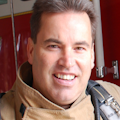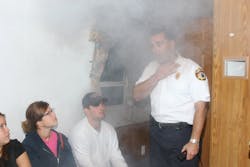Fire Prevention: Are We Teaching or Educating?
While community risk reduction (CRR) involves a multifaceted approach to achieve its end goal, at its core, it revolves around tried-and-tested core elements, specifically, the three Es of fire prevention—Education, Engineering and Enforcement. No matter what approach is taken, from installing sprinkler systems (engineering) to creating a community ordinance reducing speeds on a dangerous roadway (enforcement), it still starts with education. But educating is different than teaching. In short, teaching is providing information whereas educating is changing a belief system and, therefore, behavior. Let’s explore both approaches.
Teaching troubles
Teaching involves a transfer of information. This often means following a pre-made lesson plan of objectives, performed in a step-by-step checklist fashion. It is abstract and impersonal. Many also accomplish teaching through videos, songs and catchy phrases. The information that is taught can often be found on websites and pamphlets. The student then hears this information, possibly takes an immediate test or regurgitates the information back, which supposedly defines “successful” learning, but what are the students taking with them?
Think of the last period of instruction you participated in that was conducted in this manner. What did you retain? Did the information cause you to make a profound change in your lifestyle? What do you remember today? Can you perform the skills taught (if not a reoccurring requirement)?
One example is the catchy phrase “Stop, drop, and roll.” It is an easy slogan that identifies an action to take when your clothes catch fire, and it’s easily remembered; however, just because someone was taught the phrase and what it means does not ensure that they know how to perform the skill or why it needs to be performed in a particular manner. If their clothes were to catch fire, will they recall the information that they were taught and be able to perform the skills?
Consider another fire prevention example: Teaching a child about the dangers of playing with matches and lighters would include simply telling them about negative outcomes. The child has the information, but do they truly understand it in order to alter their behaviors?
Essential education
Clearly, those who work in CRR should seek to educate their citizens, not simply teach them. More often than not, people already know what is right and wrong. For instance, they know that if they leave food unattended on the stove, it could ignite, they know that they should have smoke alarms, and they know they should wear their life jackets and helmets. It is their perceptions and beliefs that take them down the road to a potential tragedy, and while the list of those beliefs may be long, it can be summarized into the common thought, “It won’t happen to me.” Even those who are unaware of certain risks, such as sleeping with bedroom doors open, still need to be persuaded into changing their lifelong behavior, driven by perceptions and beliefs of not closing it.
Changing perceptions and beliefs involves disrupting a person’s comfortable status quo, and doing so is an uphill battle to change. This is why fire still kills more Americans than all natural disasters and terrorist events combined, and accidents are the third leading cause of death in the United States, according to the Centers for Disease Control and Prevention (CDC). The majority of the time, when a fire truck leaves the station, it is responding to a predictable and preventable event. We have been teaching fire safety since the days of Benjamin Franklin, yet very little has changed in the cause, spread and killing nature of fire. This is not to dismiss the value of teaching, but to truly effect change, we need to focus more on the education element.
The first step in educating is to be educated on the subject yourself. This probably seems obvious, but there is a difference between being knowledgeable and educated. You may be able to describe the process of combustion and fire spread, or even the three collisions a body goes through upon impact with a stationary object. Between the internet and social media, that information can easily be found in the comfort of one’s home. So why attend a CRR class? What could that instructor provide that is not already readily available, and if new information is provided, is it provided in a manner that will make a profound change in the student’s behavior or lifestyle?
Education involves not just teaching the process of combustion but also instructing it in a manner that the student can feel the heat, smell the smoke, feel themselves choking, and see themselves collapsing. Because they can see and feel such an event happening to them, the chances increase that they will make profound changes to behaviors or lifestyles.
There is a reason that a victim’s testimony is so powerful. They lived the event. They can bring the listener into the environment through an emotional appeal that is compelling and personal. A victim who survived a fire is more fire conscious. A victim who survived a vehicle ejection is more likely to wear a seatbelt. Someone who has witnessed the above can provide an education and bring the students as close as they can get to an event without having to live it themselves. Your best public educator may be an experienced firefighter who claims to not like public speaking—but educating is not public speaking; it’s about bringing students into an experience through a conversation about something that they may never have had.
There’s a reason a good ghost story can keep a person up at night. The story is told in such a convincing manner that the listener can see the shadows and hear the bumps in the night. The story shakes their sense of personal security to a level that their subconscious is on guard. They then sleep with lights on and double-check locked doors and windows. So even if your past has not been in the emergency services, telling a compelling CRR story involves research and immersing yourself in the information—educating yourself. If your data shows overcrowding of restaurants and nightclubs to be a risk in your community, then read the history of devastating fires like the Iroquois Theater and the Station Nightclub. Read the witness descriptions and the investigator’s notes, and immerse yourself in the events in order to relive it when you educate your audience with the “ghost story” of victims and tragedies past. If your community risk is fall injuries, visit the local rehab center to work with patients and hear their stories, and understand the long, difficult rehab process.
Make the story real
Anyone can teach because it’s a simple process of transferring information from one person to another, but to educate is truly a talent. If your experience is in the emergency services, then simply tell your stories. If you are not from front-line emergency services, then take the time to immerse yourself in the subject by researching, interviewing, riding the rigs, and putting yourself in the middle of it all so you can bring your students into the “ghost story.” By doing so, you can rock their sense of status quo and security and change their belief-driven behavior.
Today’s world is saturated with information, both data and visual, through the internet. How to live a safe and healthy life is just a click away. Yet fire will kill thousands of Americans this year, and people will suffer painful and debilitating injuries, and all for the same reasons they have for decades. What is missing in this modern equation is the human CRR professional to bring that data and abstract YouTube video to life and make it real for them. Humans cause fires and injuries, and human education is what can save them.
Special thanks to Battalion Chief William Broscious III, Columbia, SC, Fire Department, and the Washington Fire Protection Institute for their assistance on this article.
About the Author

Daniel Byrne
DANIEL BYRNE is a community support officer for the Burton Fire District, Beaufort County, SC, and a retired assistant fire chief of training for the Georgia Air National Guard 165th Fire Department. A third-generation firefighter, he holds an associate degree and a bachelor’s degree in fire science as well as a master’s degree in public administration and disaster management. Byrne is an alumnus of the National Fire Academy. He received state and local awards for public relations and educational programs as well as community partnerships and served as a conference presenter and keynote speaker.
